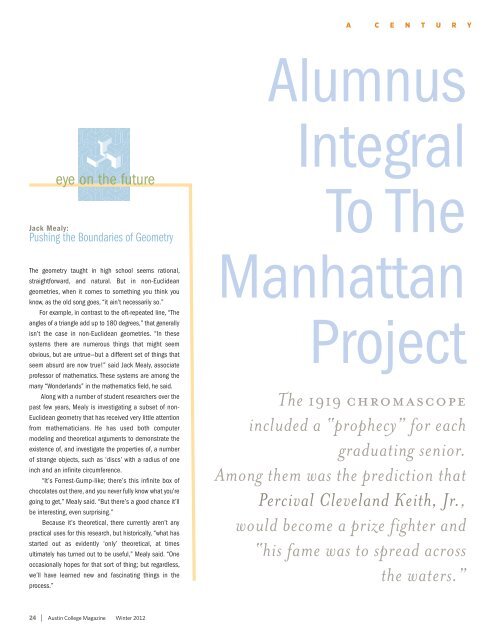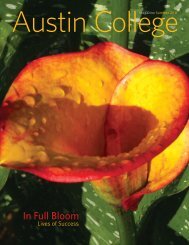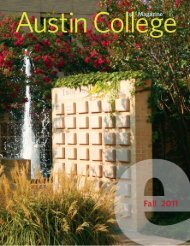Winter 2012 - Austin College Magazine
Winter 2012 - Austin College Magazine
Winter 2012 - Austin College Magazine
Create successful ePaper yourself
Turn your PDF publications into a flip-book with our unique Google optimized e-Paper software.
A C E N T U R Y<br />
eye on the future<br />
Jack Mealy:<br />
Pushing the Boundaries of Geometry<br />
The geometry taught in high school seems rational,<br />
straightforward, and natural. But in non-Euclidean<br />
geometries, when it comes to something you think you<br />
know, as the old song goes, “it ain’t necessarily so.”<br />
For example, in contrast to the oft-repeated line, “The<br />
angles of a triangle add up to 180 degrees,” that generally<br />
isn’t the case in non-Euclidean geometries. “In these<br />
systems there are numerous things that might seem<br />
obvious, but are untrue—but a different set of things that<br />
seem absurd are now true!” said Jack Mealy, associate<br />
professor of mathematics. These systems are among the<br />
many “Wonderlands” in the mathematics field, he said.<br />
Along with a number of student researchers over the<br />
past few years, Mealy is investigating a subset of non-<br />
Euclidean geometry that has received very little attention<br />
from mathematicians. He has used both computer<br />
modeling and theoretical arguments to demonstrate the<br />
existence of, and investigate the properties of, a number<br />
of strange objects, such as ‘discs’ with a radius of one<br />
inch and an infinite circumference.<br />
“It’s Forrest-Gump-like; there’s this infinite box of<br />
chocolates out there, and you never fully know what you’re<br />
going to get,” Mealy said. “But there’s a good chance it’ll<br />
be interesting, even surprising.”<br />
Because it’s theoretical, there currently aren’t any<br />
practical uses for this research, but historically, “what has<br />
started out as evidently ‘only’ theoretical, at times<br />
ultimately has turned out to be useful,” Mealy said. “One<br />
occasionally hopes for that sort of thing; but regardless,<br />
we’ll have learned new and fascinating things in the<br />
process.”<br />
Alumnus<br />
Integral<br />
To The<br />
Manhattan<br />
Project<br />
The 1919 chromascope<br />
included a “prophecy” for each<br />
graduating senior.<br />
Among them was the prediction that<br />
Percival Cleveland Keith, Jr.,<br />
would become a prize fighter and<br />
“his fame was to spread across<br />
the waters.”<br />
H<br />
24 | <strong>Austin</strong> <strong>College</strong> <strong>Magazine</strong> <strong>Winter</strong> <strong>2012</strong>





